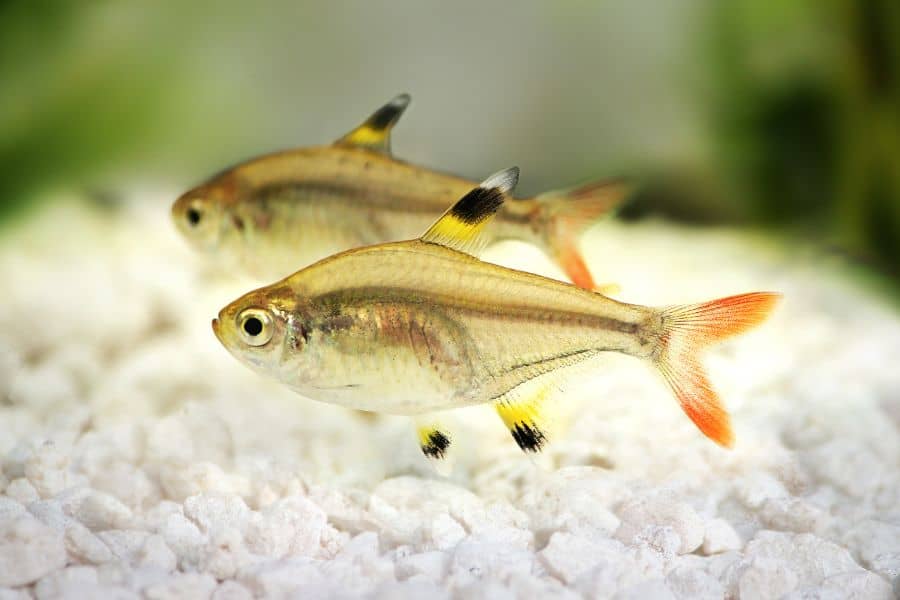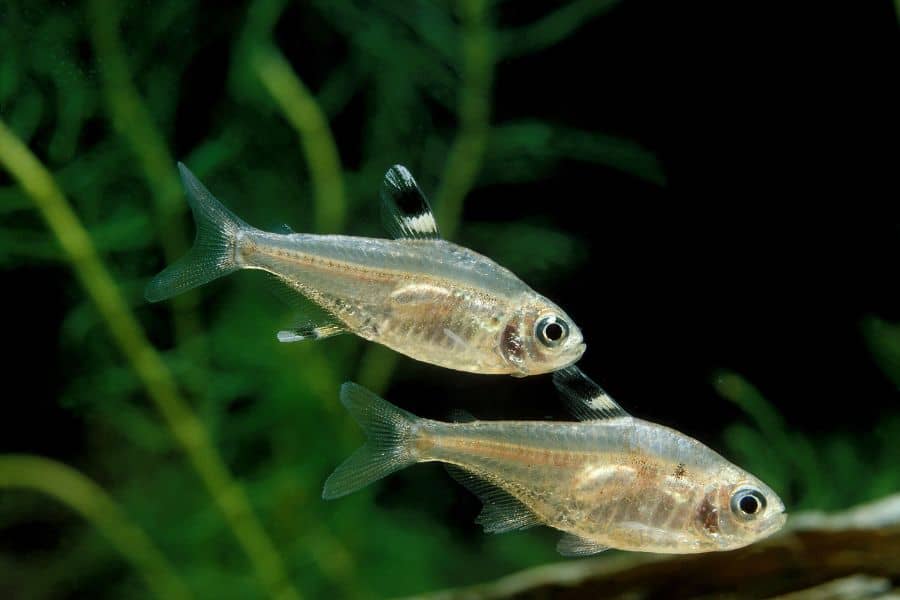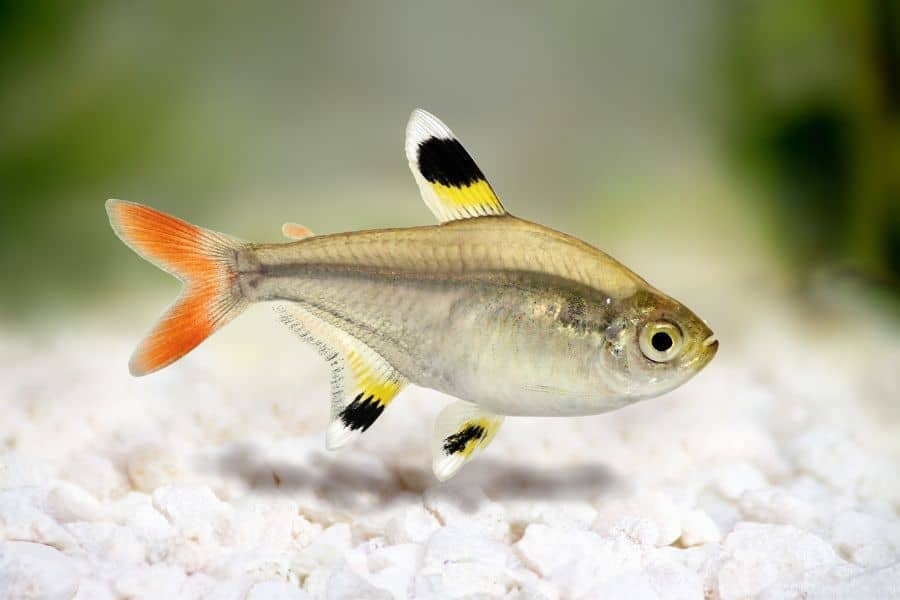When I decided to breed x-ray tetras I wanted to identify their gender of them. If I am unable to tell the difference, I may end up with two males or two females and have no success in breeding. So before going in into breeding I decided to go for x-ray tetra male or female identification.
Identifying the gender of x-ray tetras is a somewhat hard job because, most of the time, they look alike. However, if you take a close look, there are some subtle differences that will help you distinguish between males and females. This article will help you to identify the gender of your x-ray tetra fish easily.

About X-Ray Tetra Fish
Jump To
The x-ray tetra (Pristella maxillaris) is a freshwater fish of the characin family (order Characiformes). X-ray tetra is the only member of its genus. The fish is found in tropical South America, from the Orinoco River in Venezuela to the Paraná River in Argentina. It typically inhabits clear, slow-moving waters with a sandy substrate. X-ray tetra reaches a length of up to 5 cm (2 in).
The x-ray tetra is a laterally compressed fish. It has translucent fins with yellow and black markings at the tip of the fins and an orange anal fin with 14-17 soft rays. The fish’s coloration is distinctive: it is translucent with a silvery sheen and a yellowish tint that resemble nearly golden when exposed to some lights.
The x-ray tetra is a popular fish for aquariums. It is a hardy fish that can tolerate a wide range of water conditions and is relatively easy to care for. It is a peaceful fish that can be kept with other peaceful species.
How To Identify Male And Female X-Ray Tetras
Here are some features to look for when determining the gender of your x-ray tetra:
Males Are Smaller Than Females
It is difficult to tell the difference between males and females when they are juveniles. But adult males are typically smaller than females. Females can reach up to 4 cm (1.6 in) in length, while males only grow to be 3 cm (1.2 in) long. But it is not uncommon to see 2-inch males as well. Therefore, you shouldn’t use this characteristic alone to determine the gender of your fish.
Males Have Longer Fins
Another way to tell male and female x-ray tetra apart is by looking at their fins. Males have longer fins than females, particularly the dorsal and anal fins. The fins of males are also more pointed. If you are a beginner aquarist, you won’t be able to tell them apart by looking at the fins. So, it is better to try all the other characteristics before coming to a conclusion.
Males Have a Slender Body Shape
This is a distinct characteristic of x-ray tetra fish. Males tend to have a slimmer body shape than females. This is most noticeable when looking at them from above. Females tend to be rounder in shape, while males are more slender.
Males Have More Bright Colors Than Females
Males are also usually more brightly colored than female x-ray tetra fish. Their colors tend to be more intense and may have patterns that females do not have. Females tend to be drabber in coloration.
You Can spot the Eggs In Gravid Females.
If you are still unsure of the gender of your x-ray tetra, you can try to look for eggs in the gravid (egg-bearing) females. The eggs are usually visible through the female x-ray fish’s body and can be seen as small, black spots.

How Do X-Ray Tetras Breed?
Now you know how to select female and male x-ray tetras. After selecting a good breeding pair, you need to condition them. To do that place them in separate tanks and feed them well with live food and high-quality frozen food. Live food like daphnia is the best food choice for a breeding pair.
Next, you have to prepare the breeding tank. The breeding tank should resemble their natural habitat. X-ray tetra originally comes from the amazon river region. So we need to mimic those environmental conditions in your tank. To mimic the river bottom you should add peat soil to the bottom of the tank. It is to lower the pH in the tank. The reason is they need 5.5 to 6 pH to breed. Although X-ray tetra can live in a wide range of pH, they only breed in low pH water or soft water. You can find disease-free peat soil in aquarium shops.
You also need a heater to control tank temperature. These fish breed at the temperature 77 °F (25 °C) and they should be stable. Keep in mind that do not use a filter until fries become larger. Otherwise, eggs will be sucked in to filter and all of your efforts will be worthless. Apart from that add moss to the bottom of the tank. This is for fish to lay eggs. Also, provide only dim light to the tank. They do not breed in bright light. If your tank is in a sunny location cover the tank with black paper and give a very little amount of light.
After setting up the tank and conditioning your tetras only introduce them to the tank. Check all parameters before putting them into the breeding tank. If the conditions are alright they will spawn in a few days. The female lays her eggs in plants or other structures in the aquarium, and the male fertilizes them. The eggs hatch 24-48 hours later. The fry is extremely small and needs to be fed very small food items, such as infusoria or newly hatched brine shrimp. They are also very sensitive to water quality and need to be in a well-maintained aquarium.
Most importantly separate parent fish and fries as soon as possible. Otherwise parent fish will eat all fries without any hesitation. So it is your responsibility to keep an eye on them until the egg hatch.
Conclusion
The best way to tell the difference between male and female x-ray tetras is by looking at their size, fins, and body shape. Males are typically smaller than females, have longer fins, and have a more slender body shape. On the other hand, females have a rounder body shape and are usually drabber in coloration. If you are still unsure, you can try to look for eggs in the gravid females. You can easily recognize the gender of your x-ray tetra fish if you follow these simple guidelines.

Related questions
Do x-ray tetras eat their own babies?
Yes, x-ray tetras are known to eat their own eggs and fry. This is why removing the fry from the tank is important as soon as they are born.
Do x-ray tetras need a filter?
Yes, x-ray tetras need a filter in their tank. A good quality filter will help to keep the water clean and clear.
Is it easy to breed x-ray tetras?
Yes, x-ray tetras are not difficult to breed. However, providing them with the right conditions is important, such as a well-planted tank with hiding places for the fry is important.
Read Next : X-Ray Tetra Care ( With More Details On Breeding & Feeding! )
